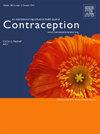在俄亥俄州,堕胎护理的强制24小时等待期很少是24小时
IF 2.3
2区 医学
Q1 OBSTETRICS & GYNECOLOGY
引用次数: 0
摘要
在2024年8月之前,俄亥俄州的法律要求至少两次面对面的预约,间隔24小时的等待期,才能进行堕胎。医疗护理标准是,人们可以在初次预约期间堕胎。为了评估延迟护理的负担,我们评估了与延长等待期相关的社会人口统计学、地理和流产特征。方法我们对2014年至2018年在俄亥俄州三家诊所寻求堕胎护理的人进行了图表回顾(n= 6196)。对于5498例接受人工流产的患者,我们计算了等待期(从亲自同意到亲自流产就诊之间的天数)。我们使用双变量对数-二项回归与聚类标准误差来估计患病率(PR)和95%置信区间与等待7+天和1-6天相关。结果中位等待时间为6 d (IQR=3 ~ 9,极差=1 ~ 78)。只有6%的患者在第一次就诊后一天就堕胎了。近一半(47%)等待7天以上;12%等了14天以上。没有大学学历的患者(PR=1.22; 95% CI, 1.01-1.47)和居住在距离诊所25英里范围内的患者(PR=1.26; 95% CI, 1.13-1.41)更有可能等待7天以上。在接受手术流产的患者中,妊娠少于15周的患者更有可能等待7天以上(PR=1.44; 95% CI, 1.10-1.88)。结论:对国家规定的等待时间的分析显示,大多数患者的等待时间远远超过24小时,而受教育程度较低的患者的等待时间更长。面对面访问之间的漫长等待加剧了流产护理的其他后勤、经济、社会和时间障碍。本文章由计算机程序翻译,如有差异,请以英文原文为准。
IN OHIO, MANDATORY 24-HOUR WAITING PERIODS FOR ABORTION CARE ARE SELDOM 24 HOURS
Objectives
Prior to August 2024, Ohio laws required at least two in-person appointments, separated by a 24-hour waiting period, to have an abortion. The medical standard-of-care is that people can have an abortion during their initial appointment. To assess the burdens in delays to care, we evaluated sociodemographic, geographic, and abortion characteristics associated with extended waiting periods.
Methods
We conducted a chart review of people seeking abortion care at three Ohio clinics from 2014 to 2018 (n=6,196). For the 5,498 patients who received an abortion, we computed waiting period (number of days between in-person consent and in-person abortion visit). We used bivariate log-binomial regressions with clustered standard errors to estimate prevalence ratios (PR) and 95% confidence intervals associated with waiting 7+ days vs. 1-6 days.
Results
The median waiting period was six days (IQR=3-9, range=1-78). Just 6% of patients had abortions one day after their first visit. Nearly half (47%) waited 7+ days; 12% waited 14+ days. Patients without a college degree (PR=1.22; 95% CI, 1.01-1.47) and those residing within 25 miles of the clinic (PR=1.26; 95% CI, 1.13-1.41) were more likely to wait 7+ days. Among patients who received a procedural abortion, those who presented at less than 15 weeks’ gestation were more likely to wait 7+ days (PR=1.44; 95% CI, 1.10-1.88).
Conclusions
Our analysis of the state-mandated waiting period shows delays that are much longer than 24 hours for most patients, and differentially longer for those with less education. Extended waiting between in-person visits compounds other logistical, economic, social, and temporal barriers to abortion care.
求助全文
通过发布文献求助,成功后即可免费获取论文全文。
去求助
来源期刊

Contraception
医学-妇产科学
CiteScore
4.70
自引率
17.20%
发文量
211
审稿时长
69 days
期刊介绍:
Contraception has an open access mirror journal Contraception: X, sharing the same aims and scope, editorial team, submission system and rigorous peer review.
The journal Contraception wishes to advance reproductive health through the rapid publication of the best and most interesting new scholarship regarding contraception and related fields such as abortion. The journal welcomes manuscripts from investigators working in the laboratory, clinical and social sciences, as well as public health and health professions education.
 求助内容:
求助内容: 应助结果提醒方式:
应助结果提醒方式:


